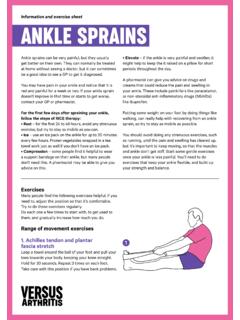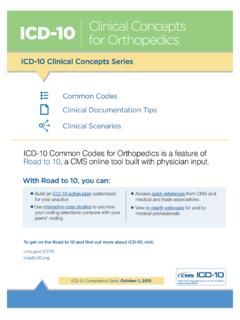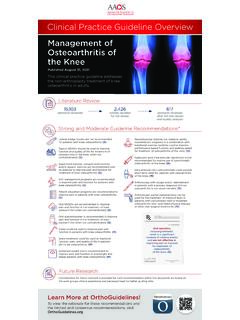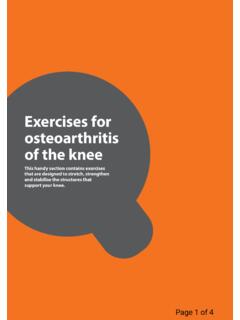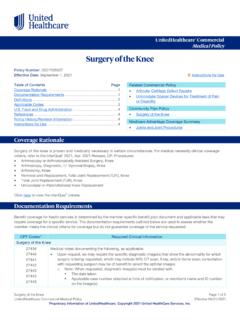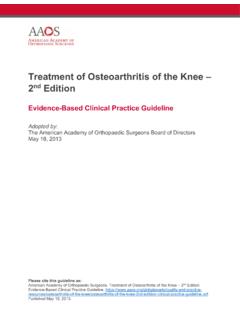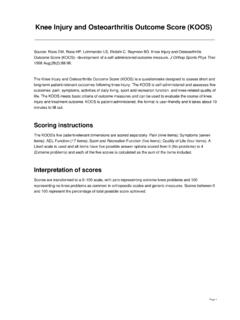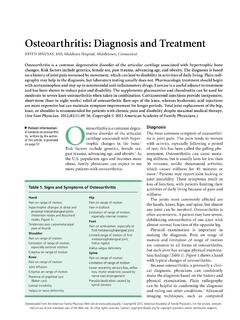Transcription of Osteoarthritis of the knee information booklet
1 Osteoarthritis of the kneeWe re the 10 million people living with arthritis. We re the carers, researchers, health professionals, friends and parents all united in our ambition to ensure that one day, no one will have to live with the pain, fatigue and isolation that arthritis understand that every day is different. We know that what works for one person may not help someone else. Our information is a collaboration of experiences, research and facts. We aim to give you everything you need to know about your condition, the treatments available and the many options you can try, so you can make the best and most informed choices for your re always happy to hear from you whether it s with feedback on our information , to share your story, or just to find out more about the work of Versus Arthritis. Contact us at office: Versus Arthritis, Copeman House, St Mary s Gate, Chesterfield S41 7 TDRegistered Charity England and Wales No.
2 207711, Scotland No. is Osteoarthritis of the knee ? 4 How will it affect me? 7 Managing Osteoarthritis of the knee 9 Exercises for Osteoarthritis of the knee 18 Where can I find out more? 22 Talk to us 0800 5200 520 What is Osteoarthritis of the knee ? Osteoarthritis (os-tee-o-arth-ri-tus) is the most common form of arthritis, and the knee is one of the most commonly affected joints. Everyone s joints go through a normal cycle of damage and repair during their lifetime, but sometimes the body s process to repair our joints can cause changes in their shape or structure. When these changes happen in one or more of your joints, it s known as joint is a part of the body where two or more bones meet in your knee , it s the thigh and shin bones. There is also a small bone at the front of the knee called the patella or ends of our bones are covered in a smooth and slippery surface, known as cartilage (car-ti-lidge).
3 This allows the bones to move against each other without friction, and protects your joint from stress. Your knee also has two other rings of a different type of cartilage known as menisci or meniscus, which help to share weight evenly across your knee joint, and there s also cartilage underneath your causes the cartilage in your knee joint to thin and the surfaces of the joint to become rougher, which means that the knee doesn t move as smoothly as it should, and it might feel painful and can affect anyone at any age, but it s more common in women over 50. Injuries or other joint problems, such as gout, can make people more likely to get Osteoarthritis . The genes we inherit from our parents can also increase the risk of the condition developing. Being overweight is also linked to Osteoarthritis , as this causes extra strain on weight-bearing joints, such as your more information on the conditions above, see the Versus Arthritis booklets: Osteoarthritis ; Gout.
4 You can view all our information online at 1. A healthy knee jointThickened, stretched capsuleMildly thickened inflamed synoviumOsteophytes (bony spurs)Roughened, thinning cartilageFigure 2. A knee joint with mild 0800 5200 520 How will it affect me?If you have Osteoarthritis of the knee , you will probably feel your knee is painful and stiff at times. It may only affect one knee , especially if you ve injured it in the past, or you could have it in both. The pain may feel worse at the end of the day, or when you move your knee , and it may improve when you rest. You might have some stiffness in the morning, but this won t usually last more than half an hour. The pain can be felt all around your knee , or just in a certain place such as the front and sides. It might feel worse after moving your knee in a particular way, such as going up or down stairs.
5 Sometimes, people have pain that wakes them up in the night. You ll probably find that the pain varies and that you have good and bad days. You might find you can t move your knee as easily or as far as normal, or it might creak or crunch as you move it. Sometimes your knee might look swollen. This can be caused by two things: Hard swelling: when the bone at the edge of the joint grows outwards, forming bony spurs, called osteophytes (os-tee-o-fites). Soft swelling: when your joint becomes inflamed and produces extra fluid, sometimes called an effusion or water on the knee . Sometimes Osteoarthritis of the knee can cause the muscles in the thighs to weaken, so your leg may look thinner. This weakness can make the joint feel unstable and could cause the knee to give way when you put weight on it. The effects of Osteoarthritis can make people feel depressed or anxious, and it can affect relationships and sleep.
6 If you have any problems like this, mention them to your doctor as there are things they can do to 0800 5200 520 Are there any complications? Osteoarthritis can develop over just a year or two, but more often it s a slow process over many years that only causes fairly small changes in just part of the knee . But in some cases, the cartilage can become so thin that it no longer covers the ends of the bones. This causes them to rub against each other and eventually wear away. The loss of cartilage, the wearing of the bones, and the bony spurs can change the shape of the joint. This forces the bones out of their normal positions, making your knee feel unstable and people with Osteoarthritis find a lump appears at the back of their knee . This is called a Baker s cyst or popliteal cyst. A Baker s cyst is a fluid-filled swelling at the back of the knee that happens when part of the joint lining bulges through a small tear in the joint capsule.
7 This can then cause joint fluid to be trapped in the bulge. It can happen on its own, but is more likely in a knee that s already affected by arthritis. A Baker s cyst doesn t always cause pain, but sometimes it can burst so the fluid leaks down into your calf, causing sharp pain, swelling and redness in the in the knee might change the way you walk or carry your weight, and this could cause you to develop the condition in other joints, such as your more information on symptoms and outlook of this condition, see Versus Arthritis booklet : Osteoarthritis . You can view all our information online at Osteoarthritis of the kneeThere s no cure for Osteoarthritis , but there are things you can do for yourself that can make a difference to how the condition affects you. There are also some treatments available that could significantly reduce your pain.
8 ExerciseJoints need to be exercised regularly to keep them healthy. It s very important to keep moving if you have Osteoarthritis of the knee . Whatever your fitness level, exercise helps the knee to be able to cope with normal daily activities again. You ll need to find the right balance between rest and exercise most people with Osteoarthritis find that too much activity increases their pain while too little makes their joints stiffen up. Exercise can 0800 5200 520strengthen the muscles around your knee , improve your posture and help you to lose weight, all of which can reduce the symptoms and pain of Osteoarthritis . It s important to carry on with your exercises even if you start to feel better, as stopping or reducing the amount of exercise you do could cause your symptoms to come back again.
9 A physiotherapist can advise you on the best exercises to do, but you ll need to build them into your daily routine to get the most benefit from ll need to find the right balance between rest and exercise too much activity may increase your pain while too little makes the joints stiffen physiotherapist may recommend exercise in a hydrotherapy pool. This can help get muscles and joints working better and, because the water is warmer than in a normal swimming pool, it can be very soothing and relaxing. Hydrotherapy is sometimes called aquatic therapy. Swimming and exercising in water can be helpful if your joints are painful, as the water takes the weight of your body which reduces any strain on your knees, but still lets you keep moving. It s important to balance this with weight-bearing exercise as well, such as walking, as this will help to keep your bones are various types of exercise that have been proven to help treat Osteoarthritis of the of movement exercisesThese are good for posture and helping to keep your joints flexible.
10 These exercises can be something as simple as stretching, making sure your joint moves through a range of positions that comfortably stretch its reach and flexibility slightly further each exercisesThis type of exercise is important to improve the strength of the muscles that control your knee , and to help stabilise and protect the joint. It s also been shown to reduce pain and can prevent your knee giving way, reducing the risk of should try to do strengthening exercises on at least two days a week if you can. Aerobic exerciseAerobic exercise is any exercise that increases your pulse rate and makes you a bit short of breath. Regular aerobic exercise can help you in many ways. It s good for your general health and well-being and can reduce pain by stimulating the release of pain-relieving hormones called endorphins.







